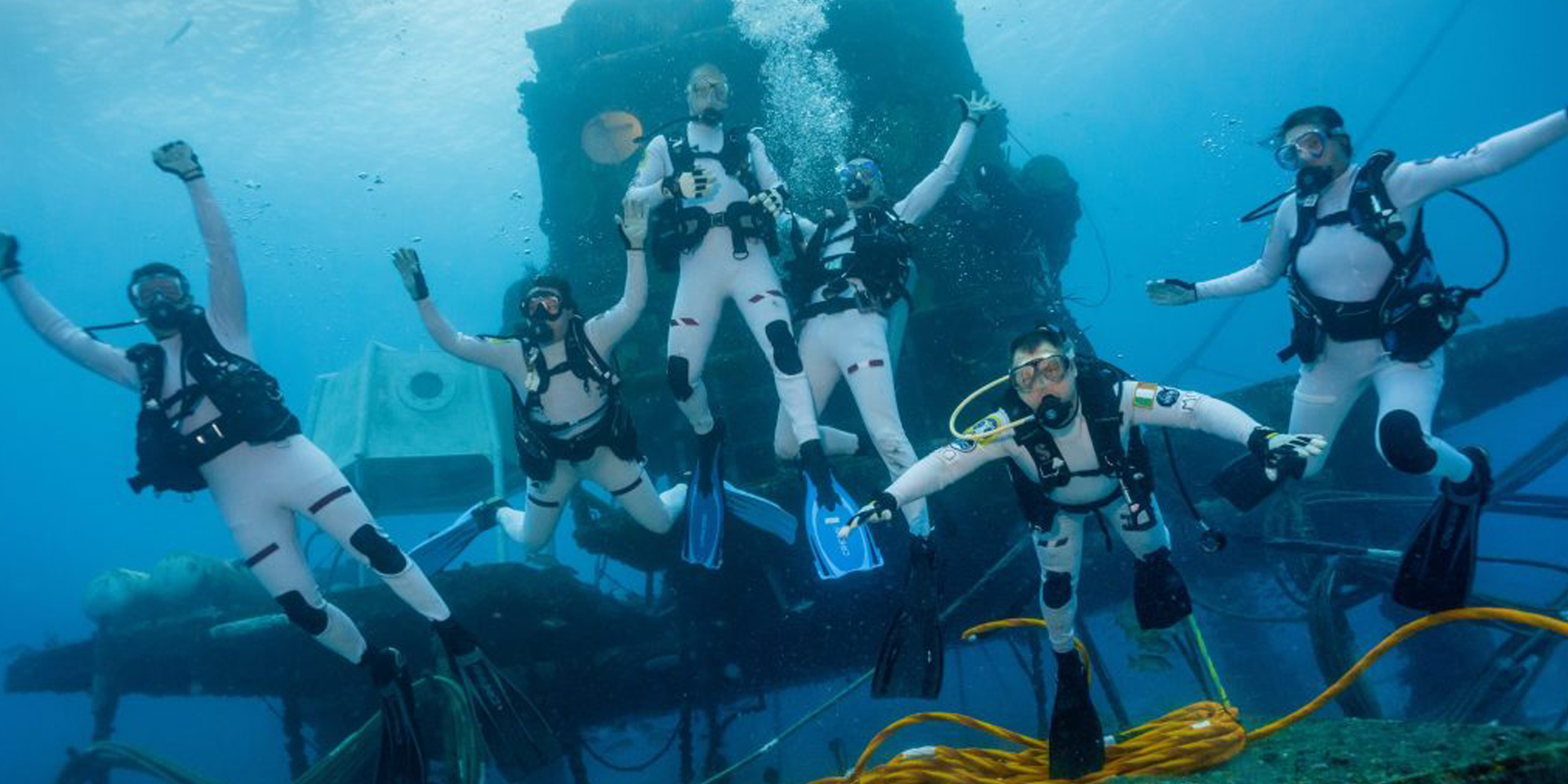
HAB.F | Aquanauts of the Hab
NASA’s Favorite Training Grounds
NASA has been sending astronauts to the Aquarius for pre-mission training for years through the NEEMO mission program. Every NEEMO mission includes 4 or 5 ‘aquanauts’ who get a first hand look at life in an environment from which there is no easy escape in an emergency. Want to meet some of the aquanauts and learn more about their missions, see how many you recognize? Have a look below! (Get it?)
NEEMO 1: October 21 - 27, 2001
NASA Aquanaut Crew: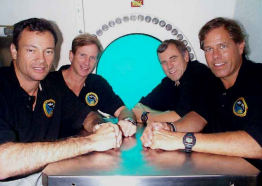
- Bill Todd, Commander
- Michael L. Gernhardt
- Michael López-Alegría
- Dafydd Williams, CSA
NURC Support Crew:
- Mark Hulsbeck
- Ryan Snow
On the first day of the mission, Williams wrote in his journal: “In contrast to the eight and a half minute flight to space where 7 million pounds of thrust were propelling us to low earth orbit, the leisurely swim to the habitat seemed quite surreal … We left the habitat at 10:04 – four aquanauts embarking on their first real dive from an underwater habitat.”
Image: The first NEEMO crew, L-R:
in front, Mike López-Alegría and Bill Todd,
in back, Mike Gernhardt and Dave Williams
Credit: NASA
NEEMO 2: May 13 - 20, 2002
NASA Aquanaut Crew: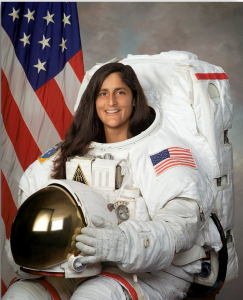
- Michael Fincke, Commander
- Daniel M. Tani
- Sunita Williams – The first woman on Aquarius; Williams formerly held the records for total spacewalks by a woman (seven) and most spacewalk time for a woman (50 hours, 40 minutes)
- Marc Reagan
NURC Support Crew:
- Thor Dunmire
- Ryan Snow
Image: Sunita Williams
Credit: NASA
NEEMO 3: July 15 - 21, 2002
NASA Aquanaut Crew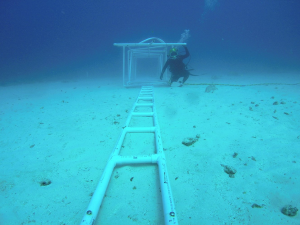
- Jeffrey Williams, Commander
- Gregory Chamitoff
- John D. Olivas
- Jonathan Dory
NURC Support Crew:
- Byron Croker
- Michael Smith
One of the experiments conducted during NEEMO 3 was the construction of an underwater structure. The experiment would provide an analog of space station assembly during extravehicular activities, or EVAs.
Image: Underwater construction
Credit: NASA
NEEMO 4: September 23 - 27, 2002
NASA Aquanaut Crew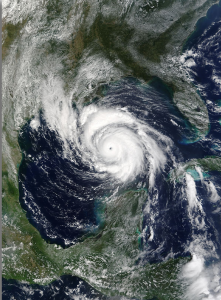
- Scott Kelly, Commander
- Paul Hill
- Rex Walheim
- Jessica Meir
NURC Support Crew:
- James Talacek
- Ryan Snow
Hurricane Isadore and Tropical Storm Lili threatened the NEEMO 4 expedition, but the crew was ultimately able to remain for the full five days.
Image: Tropical Storm Lili
NEEMO 5: June 16 - 29, 2003
NASA Aquanaut Crew:
- Peggy Whitson, Commander
- Clayton Anderson
- Garrett Reisman
- Emma Hwang
NURC Support Crew:
- James Talacek
- Ryan Snow
Whitson was the first Space Station Expedition crewmember to live aboard Aquarius, so she was able to offer a unique perspective. She wrote in her journal: “I have spent a lot of time in the last [six] months wishing that I were back living on the International Space Station … This longing to be in space is probably why this opportunity to have a mission under the sea intrigued me.”
Image: NEEMO 5’s crew
Credit: NASA
NEEMO 6: July 12 - 21, 2004
NASA Aquanaut Crew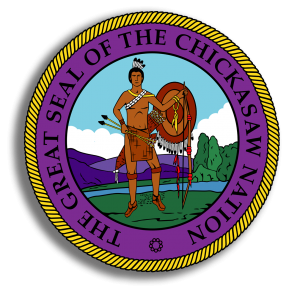
- John Herrington, Commander – Commander Herrington was born into the Native American Chickasaw Nation, and carried its flag on his thirteen-day trip to space in 2002.
- Nicholas Patrick
- Douglas H. Wheelock
- Tara Ruttley
NURC Support Crew:
- Craig B. Cooper
- Joseph March
• Marc Reagan, Mission Director
Image: Emblem of the Native American Chickasaw Nation
NEEMO 7: October 11 - 21, 2004
NASA Aquanaut Crew: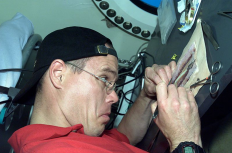
- Robert Thirsk, Commander
- Catherine Coleman
- Michael R. Barratt
- Craig McKinley
NURC Support Crew:
- James Talacek
- Billy Cooksey
• Bill Todd, Mission Director
The primary research focus of this mission was to evaluate telementoring and telerobotic surgery technologies as potential means to deliver medical care to astronauts during spaceflight.
Image: Aquanaut Dr. Craig McKinley practices a suturing technique in Aquarius
Credit NASA
NEEMO 8: April 20 - 22, 2005
NASA Aquanaut Crew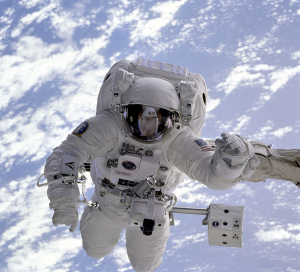
- Michael L. Gernhardt, Commander – His professional honors include 4 NASA Space Flight Medals; 2 Exceptional Service Medals; 1 Exceptional Achievement Medal and 1 Distinguished Service Medal.
- John D. Olivas
- Scott Kelly
- Monika Schultz
NURC Support Crew:
- Craig B. Cooper
- Joseph March
• Bill Todd, Mission Director
Image: Michael Gernhardt, attached to the Shuttle Endeavour’s robot arm during a spacewalk
Credit: NASA
NEEMO 9: April 3 - 20, 2006
NASA Aquanaut Crew:
- Dafydd Williams, Commander
- Nicole P. Stott
- Ronald J. Garan, Jr.
- Timothy J. Broderick, M.D.
NURC Support Crew:
- James F. Buckley
- Ross Hein
• Marc Reagan, Mission Director
During the mission, remote health care procedures were tested on a patient simulator. New long-distance medical care procedures, such as telemonitoring and telerobotic surgery, may help maintain the health of spacefarers. The techniques simulated in Aquarius can be used in remote settings on Earth, and may one day be used to respond to emergencies on the International Space Station, the moon or Mars
Image: The NEEMO 9 crew prepares for a night dive
Credit: NASA
NEEMO 10: July 22 - 28, 2006
NASA Aquanaut Crew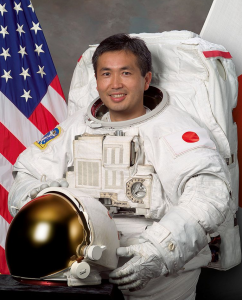
- Koichi Wakata, Commander – a veteran of four NASA Space Shuttle missions, a Russian Soyuz mission, and a long-duration stay on the International Space Station; during a nearly two-decade career in spaceflight, he has logged more than eleven months in space; the first Japanese commander of the International Space Station.
- Andrew Feustel
- Karen L. Nyberg
- Karen Kohanowich
NURC Support Crew:
- Mark Hulsbeck
- Dominic Landucci
• Marc Reagan, Mission Director
Image: Koichi Wakata
Credit: NASA
NEEMO 11: September 16 - 22, 2006
NASA Aquanaut Crew: 
- Sandra Magnus, Commander – “It was really interesting to see how just the weight distribution for this simulated space suit could dramatically change how difficult or easy it was to do different activities.”
- Timothy Kopra
- Robert L. Behnken
- Timothy Creamer
NURC Support Crew:
- Larry Ward
- Roger Garcia
• Marc Reagan, Mission Director
Image: NEEMO crewmember during a ’waterwalk’
Credit: NASA
NEEMO 12: May 7 - 18, 2007
NASA Aquanaut Crew: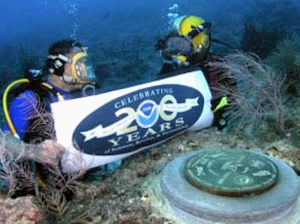
- Heidemarie Stefanyshyn-Piper, Commander
- José M. Hernández
- Josef Schmid, M.D.
- Timothy J. Broderick, M.D.
NURC Support Crew:
- Dominic Landucci
- James Talacek
• Marc Reagan, Mission Director
“A highlight of our mission today was a “ship to ship” call from the Aquarius Habitat up to the International Space Station! The ISS had just passed over the Florida Keys, and with the great help of our Public Affairs Office and Mission Control back at the Johnson Space Center, we were able to talk directly with the ISS crew. Suni Williams, a former Aquarius crew member herself, has been living on the ISS for the past six months. We had a great conversation with her, sharing her memories of living here and on the similarities on living there on the ISS.”
Image: NOAA Seafloor Marker Commemorates 200 Years Of ‘Inner Space’ Exploration
Credit: NASA
NEEMO 13: August 6 - 15, 2007
NASA Aquanaut Crew: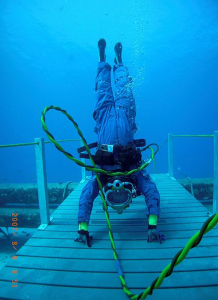
- Nicholas Patrick, Commander – “Before coming down here, most of us didn’t know the difference between coral and a sponge. I used to think of fish as wheat, something you harvest. I can’t think the word ‘supply’ and ‘fish’ in the same sentence now.”
- Richard R. Arnold
- Satoshi Furukawa
- Christopher E. Gerty
NURC Support Crew:
- James F. Buckley
- Dewey Smith
• Marc Reagan, Mission Director
Image: Commander Patrick stands on his hands to simulate the one-sixth gravity on the lunar surface
Credit: NASA
NEEMO 14: May 10 - 23, 2010
NASA Aquanaut Crew:
- Chris Hadfield, Commander – The first Canadian to walk in space; author of the bestseller, “An Astronaut’s Guide to Life on Earth;” recorded a version of “Space Oddity” on the ISS.
- Thomas H. Marshburn
- Andrew Abercromby
- Steve Chappell
Aquarius Reef Base Support Crew:
- James Talacek
- Nate Bender
- Eli Quinn
- Bill Todd, Mission Director
Image: Playing “Space Oddity” on the ISS
Credit: Rare Earth
NEEMO 15: October 20 - 26, 2011
NASA Aquanaut Crew: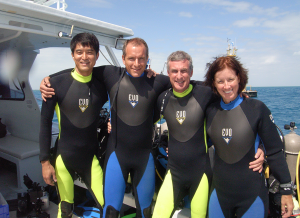
- Shannon Walker, Commander
- Takuya Onishi
- David Saint-Jacques
- Steve Squyres – Squyres has written a book called Roving Mars: Spirit, Opportunity, and the Exploration of the Red Planet (published August 2005), and appeared on the June 7, 2006 episode of The Colbert Report to discuss it, Mars, and MER. The Disney IMAX documentary film Roving Mars was made from the book.
Aquarius Reef Base Support Crew:
- James Talacek
- Nate Bender
DeepWorker 2000 Submersible Crew:
- Stanley G. Love
- Richard R. Arnold
- Michael L. Gernhardt
Image: NEEMO 15 crew members from right to left:
Shannon Walker, Steve Squyres, David Saint-Jacques, Takuya Onishi
Credit: NASA
NEEMO 16: June 11 - 22, 2012
NASA Aquanaut Crew: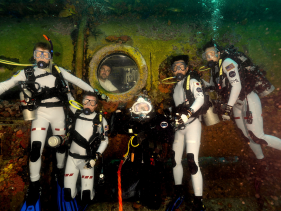
- Dorothy Metcalf-Lindenburger, Commander – Metcalf-Lindenburger taught Earth Science and Astronomy at Hudson’s Bay High School in Vancouver, Washington for five years, and coached high school cross-country running for two years.
- Kimiya Yui
- Timothy Peake
- Steve Squyres
Aquarius Reef Base Support Crew:
- Steve Chappell
- James Talacek
- Justin Brown
DeepWorker 2000 Submersible Crew:
- Stanley G. Love
- Steve Giddings
- Serena M. Auñón
- Bill Todd
- Michael L. Gernhardt
- Andrew Abercromby
Image: Tim Peake, Steven Squyres, James Talacek (inside),
Justin Brown (in the black suit), Kimiya Yui, and Dottie Metcalf-Lindenburger
Credit: NASA
SEATEST II: Sept 9 - 13, 2013 Space Environment Analog for Testing EVA Systems and Training (NEEMO 17 designation skipped)
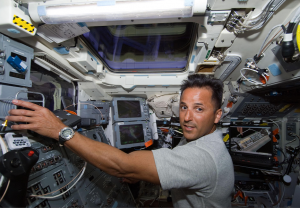 Aquanaut Crew:
Aquanaut Crew:
- Joseph M. Acaba, Commander – Acaba spent two years in the United States Peace Corps and trained over 300 teachers in the Dominican Republic in modern teaching methodologies.
- Kate Rubins
- Andreas Mogensen
- Soichi Noguchi
- Thomas Pesquet
Aquarius Reef Base Support Crew:
- Mark Hulsbeck
- Otto Rutten
Image: On board the ISS
Credit: NASA
NEEMO 18: July 21 - 29, 2014
NASA Aquanaut Crew: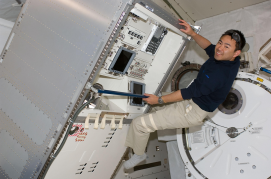
- Akihiko Hoshide, Commander – While on the ISS in 2012, Hoshide successfully recorded the first voice acting performance in space for a cameo appearance in the 31st episode of the anime television series, Space Brothers, which aired on November 4, 2012.
- Jeanette J. Epps
- Mark T. Vande Hei
- Thomas Pesquet
Professional Habitat Technician, Aquarius Reef Base Support Crew
- Hank Stark (FIU)
Image: Mission Specialist Akihiko Hoshide works
in the newly installed Kibo Japanese Pressurized Module
Photo credit: NASA/JSC
NEEMO 19: September 7 - 13, 2014
NASA Aquanaut Crew: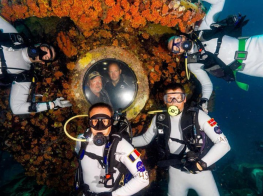
- Randolph Bresnik, Commander
- Andreas Mogensen, Flight Engineer 1
- Jeremy Hansen, Flight Engineer 2
- Hervé Stevenin, Flight Engineer 3 – Stevenin has received extensive astronaut training and is the only “non-astronaut” European citizen with spacewalk training experience inside both NASA’s Extravehicular Mobility Unit (EMU) and Russian Orlan space suit.
Aquarius Reef Base Support Crew:
- Mark Hulsbeck
- Ryan LaPete
- Eli Quinn c.e.o
Image: The NEEMO 19 crew: Left to right:
Hansen, Stevenin, Mogensen, Bresnik; inside habitat: Hulsbeck, LaPete
Credit: NASA
NEEMO 20: July 20 - August 2, 2015
NASA NEEMO 20 Aquanaut Crew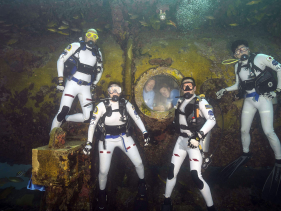
- Luca Parmitano, ESA, Commander
- David Coan, NASA EVA Management Office Engineer
- Norishige Kanai, JAXA
Professional Habitat Technicians, Aquarius Reef Base Support Crew
- Mark Hulsbeck (FIU)
- Sean Moore (FIU)
The mission objective was to simulate the time-delays associated with sending and receiving commands between controllers on Earth and astronauts on Mars. Additional EVAs will simulate working on the surface of an asteroid, and the use of DeepWorker submersible as an underwater standin for the Multi-Mission Space Exploration Vehicle.-Serena M. Auñón, NASA
Image: Luca Parmitano, Serena Aunon, David Coan, Norishige Kanai
Inside the Aquarius station: Mark Hulsbeck & Sean Moore
Credit: NASA
NEEMO 21: July 21 - August 5, 2016
NASA Aquanaut Crew: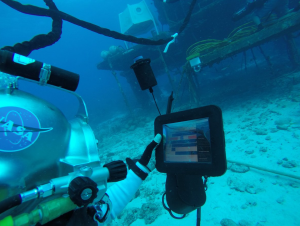
- Reid Wiseman, NASA, Commander 1.
- Megan McArthur, NASA, Commander 2
- Marc O’Griofa – Twitter handle: DiveDoc
- Matthias Maurer, ESA
- Noel Du Toit
- Dawn Kernagis
Professional Habitat Technicians, Aquarius Reef Base Support Crew
- Hank Stark (FIU)
- Sean Moore (FIU)
The NEEMO 21 mission was scheduled to begin July 18, 2016 and conclude August 3, 2016; however, the mission start was shifted to July 21, 2016 as a result of unfavorable weather conditions
Image: “Executing missions from #innerspace to #outerspace”
Credit: NASA
NEEMO 22: June 18 - 27, 2017
NASA Aquanaut Crew: 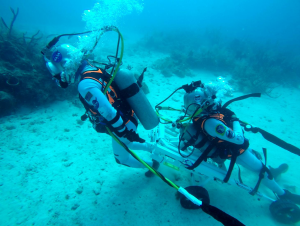
- Kjell Lindgren, NASA, Commander
- Pedro Duque, ESA
- Trevor Graff, NASA/Jacobs
- Dominic D’Agostino, USF
Professional Habitat Technicians, Aquarius Reef Base Support Crew
- Mark Hulsbeck (FIU)
- Sean Moore (FIU)
NEEMO 22 focused on both exploration spacewalks and objectives related to the International Space Station and deep space missions.
Image: NASA astronaut Kjell Lindgren pulling Pedro Duque
on a stretcher in a simulated lunar rescue
Credit: NASA
Curriculum Reference Links
- Nature of Science / Understanding About Science / 1: Students should be able to appreciate how scientists work and how scientific ideas are modified over time.
- Nature of Science / Science in Society / 10: Students should be able to appreciate the role of science in society; and its personal, social, and global importance; and how society influences scientific research.




